Zoom
Trash
Related: new docs
- histoire
- Metamorphoses by Ovid
- Fiction
- -
- Achilles
- Education
- Enterprise

Casa Fernando Pessoa: Fernando Pessoa. Cópia do original dactiloscrito por Fernando Pessoa, gentilmente cedido pelo Professor José Barreto.
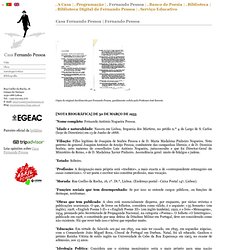
[NOTA BIOGRÁFICA] DE 30 DE MARÇO DE 1935“Nome completo: Fernando António Nogueira Pessoa. “Idade e naturalidade: Nasceu em Lisboa, freguesia dos Mártires, no prédio n.º 4 do Largo de S. Carlos (hoje do Directório) em 13 de Junho de 1888. “Filiação: Filho legítimo de Joaquim de Seabra Pessoa e de D. Maria Madalena Pinheiro Nogueira. “Estado: Solteiro. “Profissão: A designação mais própria será «tradutor», a mais exacta a de «correspondente estrangeiro em casas comerciais».
Se depois de eu morrer - Fernando Pessoa. Fernando Pessoa. Un article de Wikipédia, l'encyclopédie libre.
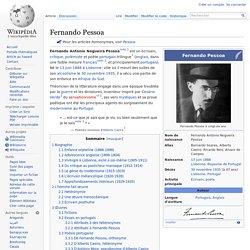
Pour les articles homonymes, voir Pessoa. Fernando Pessoa Fernando Pessoa à vingt-six ans. Fernando Pessoa. Aquila (Roman) A modern reconstruction of an aquila An aquila, or eagle, was a prominent symbol used in ancient Rome, especially as the standard of a Roman legion.
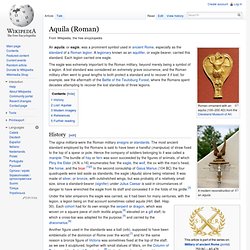
A legionary known as an aquilifer, or eagle-bearer, carried this standard. Each legion carried one eagle. Achilles. In Greek mythology, Achilles (/əˈkɪliːz/; Ancient Greek: Ἀχιλλεύς, Akhilleus, pronounced [akʰillěws]) was a Greek hero of the Trojan War and the central character and greatest warrior of Homer's Iliad.
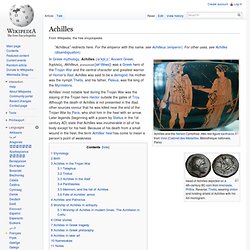
Achilles was said to be a demigod; his mother was the nymph Thetis, and his father, Peleus, was the king of the Myrmidons. Etymology[edit] Achilles' name can be analyzed as a combination of ἄχος (akhos) "grief" and λαός (Laos) "a people, tribe, nation, etc. " List of Roman legions. This is a list of Roman legions, including key facts about each legion, primarily focusing on Principate (early Empire, 27 BC - 284 AD) legions, for which there exists substantial literary, epigraphic and archaeological evidence.
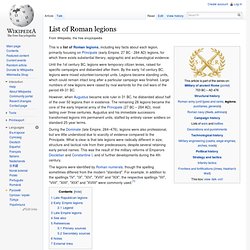
Until the 1st century BC, legions were temporary citizen levies, raised for specific campaigns and disbanded after them. By the early 1st century BC, legions were mixed volunteer/conscript units. Legions became standing units, which could remain intact long after a particular campaign was finished. Large numbers of new legions were raised by rival warlords for the civil wars of the period 49-31 BC. Ariovistus. History[edit] Sources[edit] Ariovistus and the events he was part of are known from Caesar's Commentarii de Bello Gallico.[1] Caesar, as a participant in the events, is a primary source, although as his Commentaries were in part political propaganda they may be suspected of being self-serving.
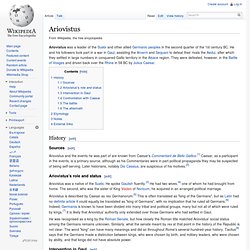
Later historians, notably Dio Cassius, are suspicious of his motives.[2] Ariovistus's role and status[edit] Julius Caesar. Gaius Julius Caesar was born on 12 July 100 BC in Rome, son of Gaius Caesar and Aurelia. Governor of Gaul 58-49 BC. Appointed dictator for ten years in 47 B, for life on 14 February 44 BC. Married initially to Cornelia (one daughter, Julia), then to Pompeia, alas to Calpurnia. Assassinated on 15 March 44 BC. Deified in 42 BC. Caesar was tall, fair-haired, well built and of sound health. though he did suffer from the occasional epileptic fit. Caesar grew up in a period of unrest and civil war in Rome. The Roman Empire, explained in 40 maps. TwoTwo thousand years ago, on August 19, 14 AD, Caesar Augustus died.
He was Rome’s first emperor, having won a civil war more than 40 years earlier that transformed the dysfunctional Roman Republic into an empire. Under Augustus and his successors, the empire experienced 200 years of relative peace and prosperity. Here are 40 maps that explain the Roman Empire — its rise and fall, its culture and economy, and how it laid the foundations of the modern world. 1) The rise and fall of Rome.
Germanic peoples. The Germanic peoples (also called Teutonic, Suebian or Gothic in older literature) are[1] an Indo-European ethno-linguistic group of Northern European origin, identified by their use of the Germanic languages which diversified out of Proto-Germanic starting during the Pre-Roman Iron Age.[2] The term "Germanic" originated in classical times, when groups of tribes were referred to using this term by Roman authors.
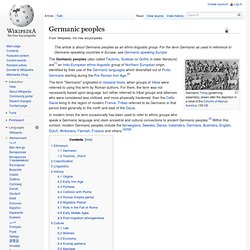
For them, the term was not necessarily based upon language, but rather referred to tribal groups and alliances who were considered less civilized, and more physically hardened, than the Celtic Gauls living in the region of modern France. Tribes referred to as Germanic in that period lived generally to the north and east of the Gauls. Ethnonym. Rothschild family - Wikipedia. A Rothschild house, Waddesdon Manor in Waddesdon, Buckinghamshire, England donated to the National Trust by the family in 1957.

House of the Rothschild family, Judengasse, Frankfurt A house formerly belonging to the Viennese branch of the family (Schillersdorf Palace). Schloss Hinterleiten, one of the many palaces built by the Austrian Rothschild dynasty. Donated to charity by the family in 1905. Celts. Diachronic distribution of Celtic peoples: core Hallstatt territory, by the 6th century BC maximal Celtic expansion, by 275 BC Lusitanian area of Iberia where Celtic presence is uncertain The Celts (/ˈkɛlts/, occasionally /ˈsɛlts/, see pronunciation of Celtic) or Kelts were an ethnolinguistic group of tribal societies in Iron Age and Medieval Europe who spoke Celtic languages and had a similar culture,[1] although the relationship between the ethnic, linguistic and cultural elements remains uncertain and controversial.
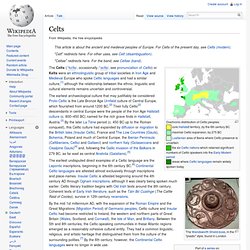
The earliest undisputed direct examples of a Celtic language are the Lepontic inscriptions, beginning in the 6th century BC.[6] Continental Celtic languages are attested almost exclusively through inscriptions and place-names. Names and terminology. The Lost World of the Maya is Finally Emerging From the Jungle. Thomas Garrison pauses in the middle of the jungle.
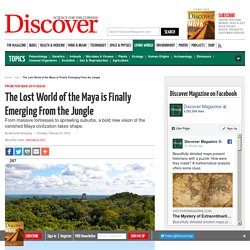
“That’s the causeway right there,” he says, pointing into a random patch of greenery in the Guatemalan lowlands. I squint, trying to make out features in the tangled rainforest undergrowth. There’s a small lump, rising no more than a foot or two from the forest floor.